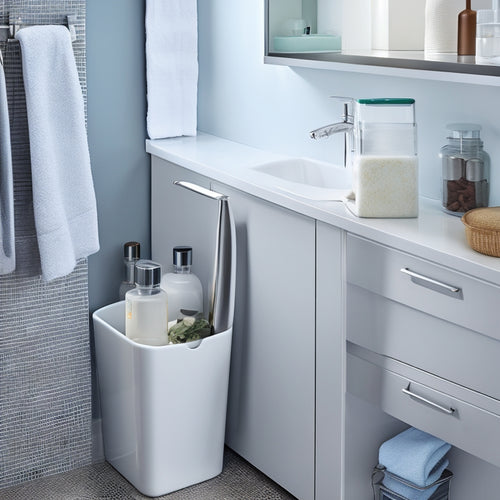
Calm Kitchen Clear Mind: Declutter for Serenity
Share
You start your journey to a calm kitchen and clear mind by clearing out the space completely to see the area clearly. Envision your ideal kitchen decor inspiration and consider the flow and storage optimization of your kitchen. Sort through items, separating what's truly useful, and make intentional decisions about what to bring back. Create a serene and functional cooking environment by assigning specific zones for meal prep, cooking, and cleaning. Next, you'll learn how to optimize your storage spaces, tame countertop chaos, and design a maintenance routine to maintain your new peaceful kitchen state.
Key Takeaways
• Clear your kitchen completely to envision your ideal decor inspiration and optimize storage and flow.
• Assign specific zones for meal prep, cooking, and cleaning to reduce clutter and chaos.
• Designate a home for each item, categorizing into groups like baking supplies, cooking utensils, and dinnerware.
• Minimize duplicates, keeping only essential items that bring joy or serve a specific purpose.
• Establish a maintenance routine, including daily upkeep and a weekly deep clean, to maintain serenity.
Start With a Fresh Slate
Start With a Fresh Slate
Clear everything out of the space you want to declutter, leaving it completely bare, so you can see what you're working with and tackle the task at hand without any distractions. This blank slate allows you to think critically about how you want to use your kitchen space.
Take a moment to envision your ideal kitchen: what kind of kitchen decor inspiration are you drawn to? Do you want a minimalist, modern aesthetic or a cozy, rustic vibe? Consider how you can create a space that sparks mindful meal planning and cooking.
Think about the flow of your kitchen, where you'll store your most-used items, and how you'll optimize your countertops for food prep. With a clear space, you can begin to make intentional decisions about what you'll bring back into your kitchen, and how you'll use it to create a serene and functional cooking environment.
Purge Unwanted Kitchen Items
With your kitchen space now completely bare, it's time to sort through your kitchen items and separate what's truly useful from what's simply taking up space. Go through each item, asking yourself when you last used it and if it still serves a purpose. Be honest – if you haven't used it in a year, it's probably safe to let it go.
Set up three boxes or bins labeled 'keep,' 'donate,' and 'recycle.' Place each item into one of these categories.
Be ruthless – if you have duplicates or items that no longer fit your cooking style, consider donating unused items to a local charity or thrift store. This won't only declutter your kitchen but also give back to your community.
Once you've purged your unwanted items, think about the layout of your kitchen. Consider rearranging the layout to maximize efficiency and flow. Think about the items you use most frequently and place them in easy-to-reach locations. By doing so, you'll create a more functional and peaceful kitchen space.
Organize Your Kitchen Zones
Now that you've purged your kitchen of unwanted items, it's time to think about how you'll use the remaining space.
You'll want to assign zones in your kitchen to create a functional and efficient workflow.
Zone Assignments Matter
Designate specific zones in your kitchen to streamline meal prep, cooking, and cleaning, and you'll be amazed at how efficiently you can tackle daily tasks. By assigning specific areas for different activities, you'll reduce clutter and chaos, making it easier to focus on the task at hand.
Start by identifying the zones you need, such as a prep zone, cooking zone, and cleaning zone.
Next, think about the storage solutions you need for each zone. For example, in your prep zone, you may need a utensil organizer or a spice rack. In your cooking zone, you may need pots and pans storage or a cookware organizer.
Consider the functional layout of each zone and how you can optimize the space to reduce clutter and increase productivity. For instance, placing your most frequently used items in easy-to-reach locations can save you time and effort.
Optimize Workflow Flow
You'll further streamline your kitchen workflow by arranging each zone in a logical sequence that mirrors the flow of your meal prep, cooking, and cleaning tasks. This optimization will save you time and energy, making cooking and cleaning a breeze.
By organizing your zones in a logical order, you'll reduce the amount of time spent walking between stations, making your workflow more efficient.
Here are some tips to help you optimize your workflow flow:
-
Designate a 'landing strip': Designate a specific area, like a countertop or a tray near the entrance, as a 'landing strip' for items that need to be put away later. This helps maintain a clutter-free kitchen and saves time.
-
Position frequently used items strategically: Place frequently used items in easy-to-reach locations to reduce walking distances and save time.
-
Create a 'cleaning station': Designate a specific area for cleaning supplies, making it easy to access what you need when you need it.
Tame the Countertop Chaos
Now that you've organized your kitchen zones, it's time to tackle the countertop chaos.
You'll start by clearing everything off your countertops and sorting items into categories, like 'keep,' 'donate,' and 'recycle.'
Next, you'll implement countertop organization tips to make sure that only the essentials remain, and they're neatly stored in designated spaces.
Clear the Clutter
Start by wiping down your countertops to remove any dust, crumbs, or spills that may be hiding underneath the clutter. This will give you a clean slate to work with and help you see what you're dealing with.
Next, take everything off your countertops and sort items into categories, such as baking supplies, cooking utensils, and appliances.
As you sort, be honest with yourself about each item. Ask yourself:
- When was the last time I used this?
- Does it bring me joy or serve a purpose?
- Is it holding sentimental value due to emotional attachment?
Be ruthless – if you haven't used it in the past year, it's likely taking up valuable space and contributing to your countertop chaos. Consider donating or recycling items that are still in good condition.
Countertop Organization Tips
Your countertops, once cluttered and chaotic, are now ready to be transformed into a haven of organization and efficiency. To achieve this, start by categorizing items into 'keep,' 'donate,' and 'discard' piles. Be ruthless – if you haven't used it in the past month, it's probably safe to let it go.
Next, assign a home for each item you're keeping, ensuring they're easily accessible and out of the way.
Opt for minimalist decor and functional design, choosing items that serve multiple purposes. For example, a utensil organizer with a built-in knife block saves space and streamlines your workflow. Invest in stylish storage solutions, such as a decorative canister or a pull-out spice rack, to keep countertops clear while maintaining easy access to essentials.
Make the most of your efficient space by grouping similar items together, like baking supplies or coffee-making essentials.
Streamline Your Storage Spaces
You'll likely find that most of your clutter accumulates in storage spaces like closets, cupboards, and shelves, making them the perfect places to begin your decluttering journey. These areas can quickly become overwhelming, but by streamlining your storage spaces, you'll be able to find what you need quickly and easily.
To get started, take everything out of your storage spaces and sort items into categories. Be ruthless – get rid of anything you don't need or use. Once you've purged your unwanted items, it's time to organize what's left.
Here are a few tips to help you do just that:
-
Use drawer dividers to separate items and keep them from getting jumbled
-
Implement a pantry organization system, such as baskets or bins, to keep food and cooking supplies organized
-
Assign a home for each item, so everything has a designated place to go back to
Optimize Your Cabinet Space
About 25% of your cabinet space is likely wasted due to inefficient storage, making it essential to maximize this valuable real estate.
To optimize your cabinet space, start by evaluating what you have and what you need. Take everything out and sort items into categories, such as baking supplies, dinnerware, and cooking utensils. Purge anything broken, expired, or unnecessary.
Next, consider vertical storage options, like stackable containers or shelves, to make the most of your cabinet's vertical space. This will help keep frequently used items within easy reach while storing less frequently used items towards the top or bottom.
Use drawer dividers to separate items within your cabinets, keeping similar items together and preventing clutter from building up again. Label each section so you can quickly find what you need.
Create a Maintenance Routine
By setting aside a few minutes each week, you can maintain your newly organized space and prevent clutter from creeping back in. This maintenance routine will help you stay on top of your kitchen's organization and keep your mind clear.
To establish a routine, start by incorporating daily upkeep into your daily habits. This can be as simple as wiping down countertops after meals or putting away dishes immediately.
For a deeper clean, set aside one day a week for a weekly deep clean. This can include tasks such as:
-
Cleaning the oven and stove
-
Wiping down refrigerator handles and knobs
-
Sweeping and mopping the floors
Designate a Home for Everything
Assign a designated spot for each item in your kitchen, ensuring everything has a clear and consistent place to be stored, making it easier to find what you need when you need it. This simple habit will help you organize efficiently, saving you time and reducing stress.
Start by categorizing items into groups, such as baking supplies, cooking utensils, and dinnerware. Then, allocate a specific area for each group, considering the frequency of use and the item's size.
Label each designated spot so you can quickly identify where things go. This visual cue will help you and others in your household maintain the organization system.
To maximize space, consider vertical storage options like shelves, hooks, or a pegboard. Install a spice rack or a utensil organizer near your cooking station to keep essential items within easy reach.
Let Go of Duplicates and Triplicates
Now that you've designated a home for everything in your kitchen, it's time to tackle the clutter that's accumulated from having multiple items serving the same purpose. Take a closer look at your kitchen utensils, gadgets, and dishes.
You'll likely find that you have duplicates or even triplicates of certain items. This is a great opportunity to simplify your kitchen and reduce decision fatigue.
- Identify the items you use most frequently and consider letting go of the rest.
- Donate excess items that are still in good condition to reduce waste and support your community.
- Keep only what brings you joy or serves a specific purpose, and let go of the rest.
Related Posts
-

Community Engagement: Learning Through Professions
Community engagement is a powerful tool for fostering a deeper understanding of various professions among children. B...
-

Revamp Your Under-Sink Setup Like a Pro
To revamp your under-sink setup like a pro, start by evaluating your space and categorizing existing items, taking no...

